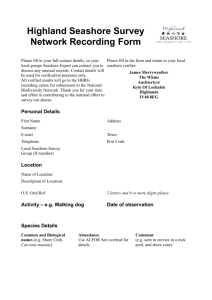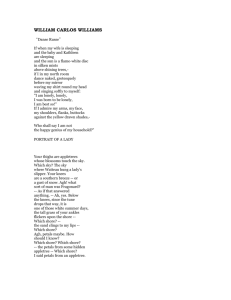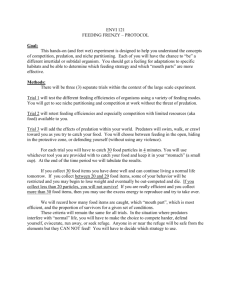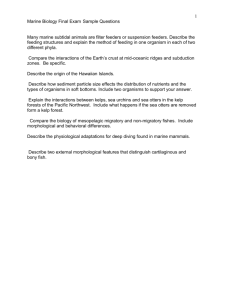The seashore food cycle - Department of Conservation
advertisement
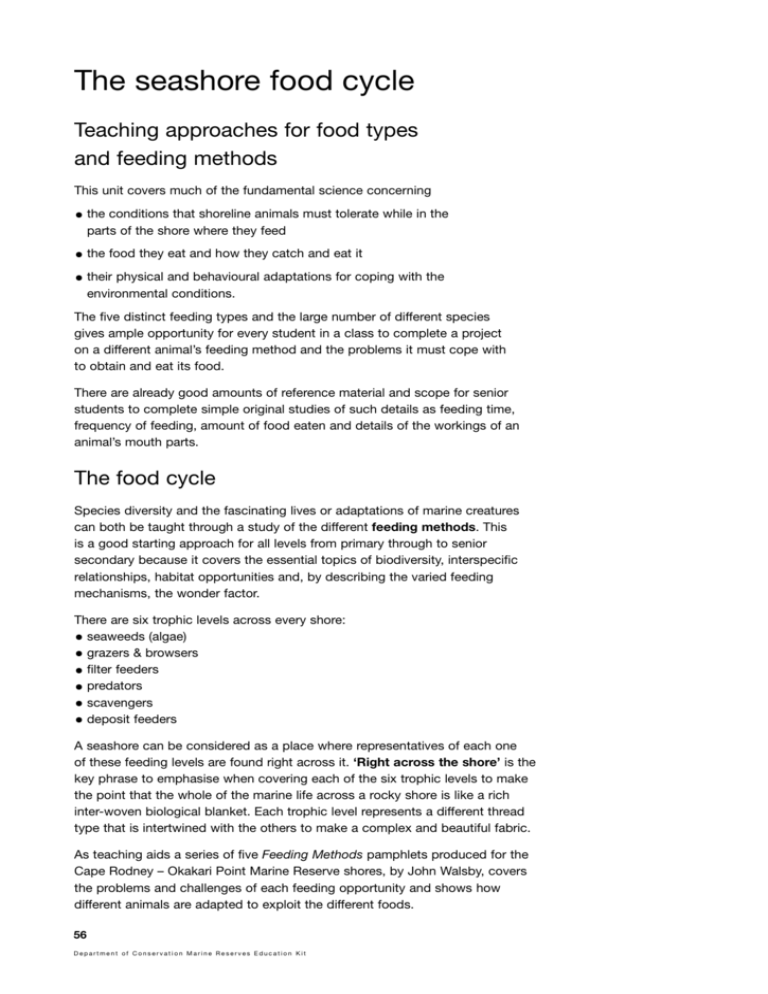
The seashore food cycle Teaching approaches for food types and feeding methods This unit covers much of the fundamental science concerning conditions that shoreline animals must tolerate while in the • the parts of the shore where they feed • the food they eat and how they catch and eat it physical and behavioural adaptations for coping with the • their environmental conditions. The five distinct feeding types and the large number of different species gives ample opportunity for every student in a class to complete a project on a different animal’s feeding method and the problems it must cope with to obtain and eat its food. There are already good amounts of reference material and scope for senior students to complete simple original studies of such details as feeding time, frequency of feeding, amount of food eaten and details of the workings of an animal’s mouth parts. The food cycle Species diversity and the fascinating lives or adaptations of marine creatures can both be taught through a study of the different feeding methods. This is a good starting approach for all levels from primary through to senior secondary because it covers the essential topics of biodiversity, interspecific relationships, habitat opportunities and, by describing the varied feeding mechanisms, the wonder factor. There are six trophic levels across every shore: seaweeds (algae) grazers & browsers filter feeders predators scavengers deposit feeders • • • • • • A seashore can be considered as a place where representatives of each one of these feeding levels are found right across it. ‘Right across the shore’ is the key phrase to emphasise when covering each of the six trophic levels to make the point that the whole of the marine life across a rocky shore is like a rich inter-woven biological blanket. Each trophic level represents a different thread type that is intertwined with the others to make a complex and beautiful fabric. As teaching aids a series of five Feeding Methods pamphlets produced for the Cape Rodney – Okakari Point Marine Reserve shores, by John Walsby, covers the problems and challenges of each feeding opportunity and shows how different animals are adapted to exploit the different foods. 56 Department of Conservation Marine Reserves Education Kit THE SEASHORE FOOD CYCLE The seashore food cycle. From ‘Nature watching at the Beach’ by John Walsby 57 Department of Conservation Marine Reserves Education Kit THE SEASHORE FOOD CYCLE The book Nature Watching at the Beach by John Walsby (held in many school libraries) is largely structured around the different feeding methods and is designed in short sections suitable in content and layout for classroom lessons. Food types and feeding methods Seaweeds Right across every hard shoreline perfect conditions exist for growing plants. The five essentials are all present. These are water, sunlight and carbon dioxide for photosynthesis, oxygen for respiration and nutrients to provide the range of minerals necessary to make the varied constituents of plant tissue. Seawater is rich in dissolved nutrients and the turbulence of the sea and waves breaking on the shore keeps the surface waters saturated with air containing oxygen and carbon dioxide. Levels of sunlight are always high because seashores are usually exposed to full daylight. A seashore can therefore be separately considered as a place where plants grow. Because of different levels of wave stress (wrenching and scouring) and desiccation stress, different types of plants are found at different heights on the shore but some that are able to cope are found at every level. Just out from low tide mark (but sometimes washed up in the drift line where they can be studied) are kelp plants and as a fringe around extreme low water are swathes of bladder wracks. In the lower intertidal zone are beaded strings of Neptune’s necklace weed and some other seasonal seaweeds. Further up the shore where conditions are more difficult are swards of low-cropped coralline turf and encrusting leathery or rubbery algal scabs. At the very top of the shore is a zoned sequence of different lichens. Grazers and browsers Plants present a feeding opportunity for animals wherever they grow and right across every shore are plant feeders. These are mostly grazing snails that scrape up algal films but sea urchins, sea hares and some crabs are all browsers of larger seaweeds. Around the high tide mark the rocks often look quite bare of plants but they are still places where plants grow. This is certain because the bare rocks are covered with grazing snails dependant on algal films for food, which they scrape from the rock surface when the tide is in. Although these rocks appear bare they must produce plenty of algal food for so many grazing snails to be living there. The rocks look bare because the snails do nothing but feed and every day they strip the surface of algae that begin to develop from newly settled spores. 58 Department of Conservation Marine Reserves Education Kit THE SEASHORE FOOD CYCLE Filter feeders Algae grow on the rocks but there is another algal resource delivered right across the shore twice every day. This is the microscopic plant plankton (phytoplankton) suspended and growing in the surface waters of the sea where the light is strong. There are filter feeding animals right across every shore that exploit this reliable food resource, and representatives from almost every animal group have some examples that have evolved as filter feeders. Animals from different groups use a variety of methods to sieve and strain this food from the sea. Predators Grazers and filter feeders are herbivores that turn plant matter into animal flesh and therefore they in their turn become a food resource for carnivores. As the herbivores are found wherever algae grow or the plankton laden sea flows, there are predators right across every shore. Catching mobile prey or penetrating the external armour of both mobile and fixed herbivores in difficult wave-swept conditions presents predators with complex challenges, and many are specially adapted to feed on particular prey species. Revealing the secrets of predators, their captures, kills and methods of feeding gives students opportunities to enjoy wildlife drama as exciting as any they might see in the best television nature programmes. Scavengers All animals eventually die – millions die every day – but shores are not littered with smelly, rotting bodies because scavengers, the undertakers of the seashore, rapidly and efficiently clear away the corpses. Indeed so competitive is this business in the sea that many animals are disposed of as soon as they become sick and too weak to protect themselves. And as death occurs, of course, right across every shore, scavengers are also found from the bottom to the top. The stories of how different scavengers locate dead and dying food, penetrate any passive armour and compete with other scavengers, make good teaching topics on the adaptations of different animal groups for solving common problems. Deposit feeders All animals that feed must defecate and the masses of faeces produced everyday (but generally overlooked in most shore studies), along with rotting fragments of animal and plant matter broken up by wave action or sand scour, make another food resource that is found right across every shore. Animals from a number of different groups specialise in exploiting this valuable resource and thereby assist in the process of recycling animal and plant remains. Where these animals live on the shore and how they gather up the fine fragments can be taught as a separate study. The lives of deposit feeding species are also good topics for individual senior project studies as many of the numerous examples feed on surface debris, making them easy to observe in the field or in classroom aquaria. Biodiversity 59 Department of Conservation Marine Reserves Education Kit THE SEASHORE FOOD CYCLE 60 Department of Conservation Marine Reserves Education Kit THE SEASHORE FOOD CYCLE 61 Department of Conservation Marine Reserves Education Kit
